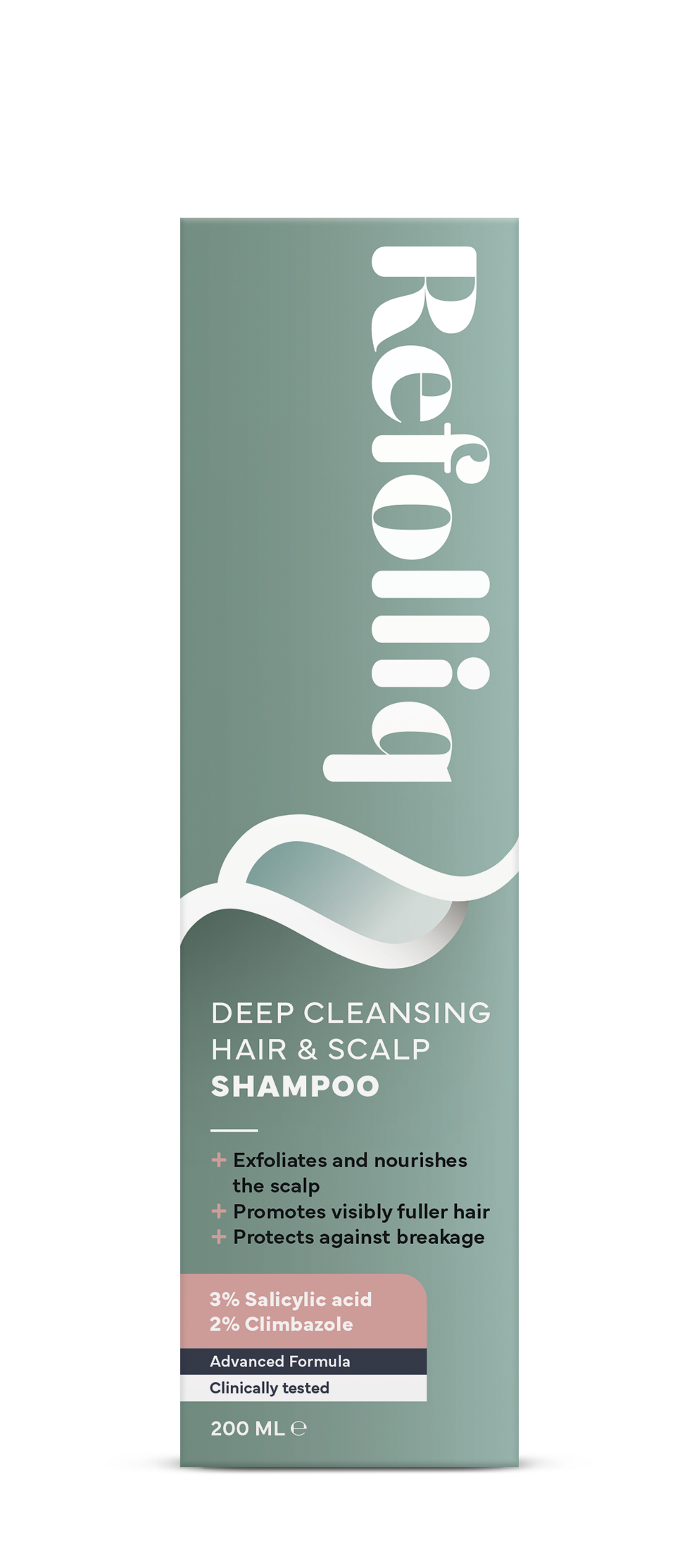Refolliq, treating pathological hair loss
About hair loss
Hair loss, or alopecia, is a common issue and can affect anyone. Understanding the cause of your hair loss is essential for making the right decisions moving forward. So what causes it, and what are the symptoms you might experience. Here’s what you should know.

Do you experience hair thinning or hair loss?
It is normal to shed some hair each day, as part of your hair’s usual growth cycle. We can lose between 50 and 100 hairs daily, usually without even realising it. For most people, the lost hair eventually regrows, allowing you to keep a full head of hair. But excessive hair loss can lead to thinning hair, bald spots, and even complete baldness.
Hair loss, or alopecia, is a condition that occurs when the body’s natural hair production cycle is disrupted. Hair loss can happen anywhere on the body, though it most frequently affects the scalp and it can be temporary or permanent.
If you’re dealing with hair loss, you should know that you’re not the only one. Hair loss can happen to any person, regardless of gender or age. There is always a cause behind hair loss and thinning hair. And in most cases, there are steps you can take to fix or at least reduce the issue.
Understanding the lifecycle of hair
Typically, the scalp has about 100,000 hairs that go through cycles of growth, rest, shedding, and renewal.

ANAGEN PHASE
The anagen phase is the active growth stage of the hair cycle. During this phase, which can last between 2-7 years depending on various factors such as genetics, age, and overall health, your hair is actively growing at a rate of about 1.25 cm per month. At any given time, up to 90% of the hairs on your head are in the anagen growth phase.

CATAGEN PHASE
At the end of the anagen phase, the hair follicle enters the 2-3 week catagen phase, a transitional stage during which it shrinks and detaches from the blood supply. The hair, now called a club hair, stops growing but remains in the follicle. Only about 1-3% of your hair is in the catagen phase at any time.

TELOGEN PHASE
Next, the hair enters the telogen phase, also known as the resting phase. This phase lasts around 3-4 months, during which the hair follicle remains dormant and no new hair growth occurs. The hair stays in the follicle but detaches from the root, making it easy to shed. This phase affects about 10% of the hair on the scalp.

EXOGEN PHASE
The final phase of the hair growth cycle is the exogen phase, which is the shedding of the hair. During this phase, the hair that has reached the end of its life cycle is released from the follicle, making way for new hair to grow.
What influences hair growth cycles
Various factors crucially impact the length and health of your hair growth cycles. Let’s explore these key influences.
Age
As we age, our hair growth cycles naturally change. The hair follicles may spend more time in the resting (telogen) phase, which means hair growth slows down. This can lead to thinner hair, less dense hair.
Genetics
Your genetic makeup has a major influence on your hair growth. It determines not only the potential maximum length of your anagen phase, but also your chances of developing conditions like male-pattern and female-pattern hair loss.
Hormonal Fluctuations
Hormones, like testosterone, estrogen, and thyroid hormones, can greatly impact hair growth cycles. Imbalances in these hormones can lead to changes in the hair growth cycle, resulting in thinning, shedding, or even excessive growth. Significant hormonal changes, such as during pregnancy, menopause, or certain medical conditions, can trigger noticeable changes in hair growth patterns.
Lifestyle Factors
Lifestyle choices, such as stress, nutrition and medications can also influence hair growth cycles. Chronic stress, for example, can disrupt the hair growth cycle and lead to increased shedding. A balanced diet rich in vitamins and minerals, on the other hand, can support healthy hair growth.

How hair loss occurs
For optimal hair growth, it’s vital to maintain a healthy balance between the Anagen, Catagen, and Telogen phases. In a healthy scalp, about 90% of hairs are in the growth (anagen) phase, while 10% are in the resting (telogen) phase. Most people lose up to 100 strands of hair daily but new strands continuously grow in to replace them. When hair loss occurs, this balance shifts, resulting in a lower ratio of hairs in the growth phase and a higher proportion in the resting phase. Disruptions in this cycle can lead to hair loss, thinning, and growth issues.
Types of hair loss
Hair loss comes in various forms, each with its own unique causes and impacts. It can be concentrated in specific areas of the scalp or spread out across the entire head. Hair loss can also be short-term (less than 6 months) or long-term (more than 6 months).
The most common types of hair loss are:
REACTIONAL HAIR LOSS
Telogen Effluvium
This type of hair loss, which is more common in women, involves a sudden and rapid shedding over a short period. It usually occurs a few months after the occurrence of a triggering event. This is why it is also known as ‘reactive hair loss’. Typical triggers include:
• Childbirth: postpartum period
• Severe trauma or illness
• Surgical operation
• Stressful life events
• Psychological stress
• Fatigue
• Weight loss
• Unbalanced diet, or nutritional deficiency
• Excessive sun exposure.
• Seasonal changes
Many follicles enter the resting phase (telogen) without transitioning to the next growth phase, leading to widespread hair shedding without new growth. Normally only 10% of the scalp hair is in the telogen phase, but in telogen effluvium this increases to 30% or more. People with this condition don’t lose all their hair, but it may become noticeably thinner. With telogen effluvium, you could lose as many as 300 hairs per day. While this condition can impact hair across the entire scalp, it most commonly affects the top of the head rather than the back or sides.
Fortunately, telogen effluvium is usually reversible, and your hair often regrows once the underlying stress is resolved.
CHRONIC HAIR LOSS
Androgenic Alopecia
This hereditary form of baldness is the most common type of hair loss and can affect both men and women, commonly known as male pattern baldness or female pattern hair loss. Androgenetic alopecia is caused by both genetic and hormonal factors. This type of hair loss is associated with hormones known as androgens, especially dihydrotestosterone (DHT). If you carry a certain gene variation, your hair follicles are more sensitive to DHT. Increased levels of DHT in hair follicles can lead to the shrinking of hair follicles, ultimately resulting in thinning hair and hair loss.
Genetic hair loss follows a predictable pattern. In men, who often experience this type of hair loss earlier and more frequently than women, it typically begins at the temples and progresses in an M-shaped pattern. In women, genetic hair loss tends to be less noticeable but more widespread. It often happens at the crown of the scalp while the frontal hairline is mostly preserved.
Although androgenetic alopecia cannot be prevented, there are treatments available that can either slow down the progression of hair loss or restore hair permanently. Topical treatments can be a good first choice or an additional option for people experiencing early or moderate hair loss due to androgenetic alopecia.
Alopecia Areata
Alopecia areata is an autoimmune condition where the immune system mistakenly attacks healthy tissues, including hair follicles, leading to hair loss and inhibiting new hair growth. It affects individuals of all ages, genders, and racial and ethnic backgrounds. The precise reason for this immune system response is not well understood. Around 20% of those with alopecia areata have a family member with the condition.
This type of hair loss causes hair loss on the scalp, face, or sometimes other areas like the underarms or legs. Typically, hair loss from alopecia areata occurs in circular patches on the scalp, but in more severe cases, it can result in complete hair loss.
There is no cure for alopecia areata, but treatments can help slow further hair loss and encourage regrowth. Treatment options depend on the type, age, and extent of hair loss, focusing on either disrupting the immune response or stimulating hair follicles, especially in milder cases.
Anagen Effluvium
Anagen effluvium is a form of non-scarring hair loss where the hair follicles remain intact and are not permanently damaged, making it possible for normal hair regrowth to occur. This type of hair loss occurs during the anagen (growth) phase of the hair cycle. It arises from a sudden, severe disruption to the hair follicles, which can be caused by internal or external factors, leading to quick and widespread shedding of hair. Medical treatments like chemotherapy are common triggers for this rapid hair loss.
Discover more about Refolliq!
OUR PHILOSOPHY
Hair has the power to transform your life and well-being. Addressing hair loss isn’t just about restoring hair—it’s about empowering individuals to embrace life with renewed energy and confidence.
OUR INGREDIENTS
Ever wonder about the ingredients in your products and why they’re used? We’ve taken the guesswork out with our ingredient glossary—a comprehensive guide to every ingredient in our products, carefully chosen and assessed.
Read all about hair
and scalp care
Explore our blog articles to learn all about hair loss and hair growth. We provide in-depth information and practical tips to help you understand and address these common hair concerns.


